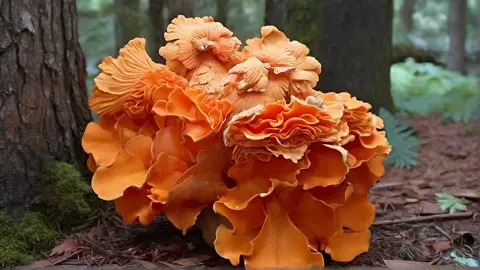Hey there, foragers and foodies alike! Ever heard of Chicken of The Woods? If you’re into wild mushrooms, this one’s bound to catch your attention. But here’s the burning question: Are they actually good to eat? Let’s dig in and find out!
Let’s dive into the fascinating world of Chicken of The Woods, a mushroom that’s as intriguing as its name suggests. Also known as Laetiporus, this vibrant fungus stands out with its bright yellow or orange shelves that often cluster on the bark of trees.
Are Chickens of The Woods Good to Eat?
Chickens of the woods is safe to eat when cooked perfectly. Additionally, the mushroom may cause an allergic reaction in some people.
With its unique appearance and texture, it’s no wonder it’s earned the nickname “Chicken of The Woods.” For more details, let’s know, What is Chicken of The Woods?
Now, here’s the juicy question: Are these vibrant forest finds actually good to eat? It’s a question that sparks curiosity and debate among foragers and food enthusiasts alike.
Some swear by its delicious taste and versatility in cooking, while others tread cautiously due to potential risks. So, let’s unravel the mystery and find out if Chicken of The Woods deserves a spot on your plate!
Chicken Of The Woods Identification
Meet the Chicken of the Woods! Picture vibrant, sunset-orange shelves adorning a tree trunk— that’s it! Named for its resemblance to poultry, this fungi boasts a soft, spongy texture and hues ranging from bright orange to yellow.

It’s like stumbling upon a cluster of chicken tenders in the wild!
Habitat and Seasonal Availability
Found mainly in North America and Europe, these fungi favor hardwood trees like oak or chestnut. Keep your eyes peeled from late summer to early autumn, prime time for spotting them. Fallen or decaying trees are their preferred hangouts.
Varieties and Common Species
There’s a variety to spice up your foraging adventures! Look out for Laetiporus sulphureus with its zesty lemony flavor, or Laetiporus cincinnatus, known for its softer texture and smaller clusters. Happy hunting!
Benefits of Chicken of The Woods
Now, why bother with these funky-looking fungi? Well, for starters, they’re packed with nutrients like protein, fiber, and various vitamins and minerals. Plus, they’re a versatile ingredient in the kitchen, adding a savory, umami flavor to any dish. Bonus points for being eco-friendly too, since they’re a renewable resource when harvested responsibly.
How to Cook Chicken Of The Woods?
Alright, so you’ve got your hands on some Chicken of The Woods. Now what? First things first, give ’em a good rinse to remove any dirt or critters. From there, the culinary world is your oyster… or should I say, mushroom?
You can sauté them with garlic and herbs, toss them into soups and stews, or even bread and fry them for a crispy treat. The possibilities are endless!
Chicken of The Woods Recipes
Looking to add a unique twist to your culinary repertoire? Consider incorporating Chicken of the Woods mushrooms into your recipes. These vibrant, flavorful fungi offer a delightful alternative to traditional meats and mushrooms.
For a simple yet satisfying dish, try sautéing Chicken of the Woods with garlic, olive oil, and a sprinkle of salt and pepper to create a delectable “Garlic Butter Chicken of the Woods.”

For a gourmet touch, experiment with incorporating Chicken of the Woods into dishes like “Creamy Chicken of the Woods Risotto” or “Spicy Chicken of the Woods Stir-Fry.” These recipes highlight the mushroom’s tender texture and umami-rich flavor, creating dishes that are both comforting and complex.
Whether you’re a seasoned chef or an adventurous home cook, Chicken of the Woods mushrooms are sure to inspire creativity in the kitchen. So why not give them a try and elevate your culinary creations to new heights?
When Should You Not Eat Chicken of The Woods?
Now, before you go all in, there are a few things to keep in mind. While Chicken of The Woods is generally safe to eat, there are some lookalikes out there that can be toxic. It’s crucial to know how to identify them correctly to avoid any unpleasant surprises.
Also, be mindful of where you’re foraging – mushrooms can absorb toxins from their environment, so steer clear of polluted areas.
What’s the Best Way to Eat Chicken of The Woods?
Ah, the million-dollar question! Honestly, there’s no wrong way to enjoy Chicken of The Woods. Whether you’re tossing them in pasta, topping a pizza, or simply sautéing them with butter, they’re sure to be a hit. Just let your creativity run wild and experiment with different flavors and techniques. Who knows, you might just discover your new favorite dish!
So, are Chickens of The Woods good to eat? Absolutely! With their unique flavor, nutritional benefits, and culinary versatility, they’re a must-try for any adventurous eater. Just remember to forage responsibly, stay safe, and savor every bite of nature’s bounty. Happy hunting!

Some common queries on this Chicken of the woods
1. Is Chicken of the Woods safe to eat?
Yes, Chicken of the Woods is generally safe to eat, but it’s crucial to correctly identify the mushroom to avoid any harmful look-alikes.
2. When should you not eat Chicken of the Woods?
Avoid consuming Chicken of the Woods if it’s growing on poisonous trees or contaminated with pollutants from the environment.
3. What does Chicken of the Woods taste like?
Chicken of the Woods has a flavor often described as resembling chicken or crabmeat, with a savory, umami taste.
4. Can you eat the entire Chicken of the Woods?
Yes, you can eat the tender parts of the Chicken of the Woods mushroom. However, it’s best to avoid consuming old or tough specimens, as they may be unpleasantly fibrous.
5. How do you prepare Chicken of the Woods for eating?
Chicken of the Woods can be prepared similarly to chicken or other mushrooms. It can be sautéed, grilled, roasted, or used in soups and stir-fries.
6. Are there any health benefits to eating Chicken of the Woods?
Chicken of the Woods is low in fat and calories but rich in protein, fiber, vitamins, and minerals, making it a nutritious addition to a balanced diet.
7. Are there any risks associated with eating Chicken of the Woods?
While Chicken of the Woods is generally safe for most people, some individuals may experience allergic reactions or gastrointestinal upset. Always start with a small portion if trying it for the first time.
8. How do you store Chicken of the Woods after harvesting?
Store Chicken of the Woods in a paper bag in the refrigerator for up to a week. Alternatively, you can freeze it for longer-term storage.
9. Can Chicken of the Woods be cooked in the same way as chicken?
Yes, Chicken of the Woods can be used as a vegetarian or vegan substitute for chicken in many recipes, such as sandwiches, salads, pasta dishes, and more.
10. How can you differentiate Chicken of the Woods from look-alike mushrooms?
Chicken of the Woods has distinctive characteristics, including its bright yellow or orange coloration, shelf-like growth pattern, and absence of gills or pores on the underside. However, it’s essential to consult with an experienced forager or mycologist for proper identification.
Additionally, You can also like and, follow us on Pinterest, and Reddit for more updates. Your thoughts and engagement are greatly appreciated!


4 comments